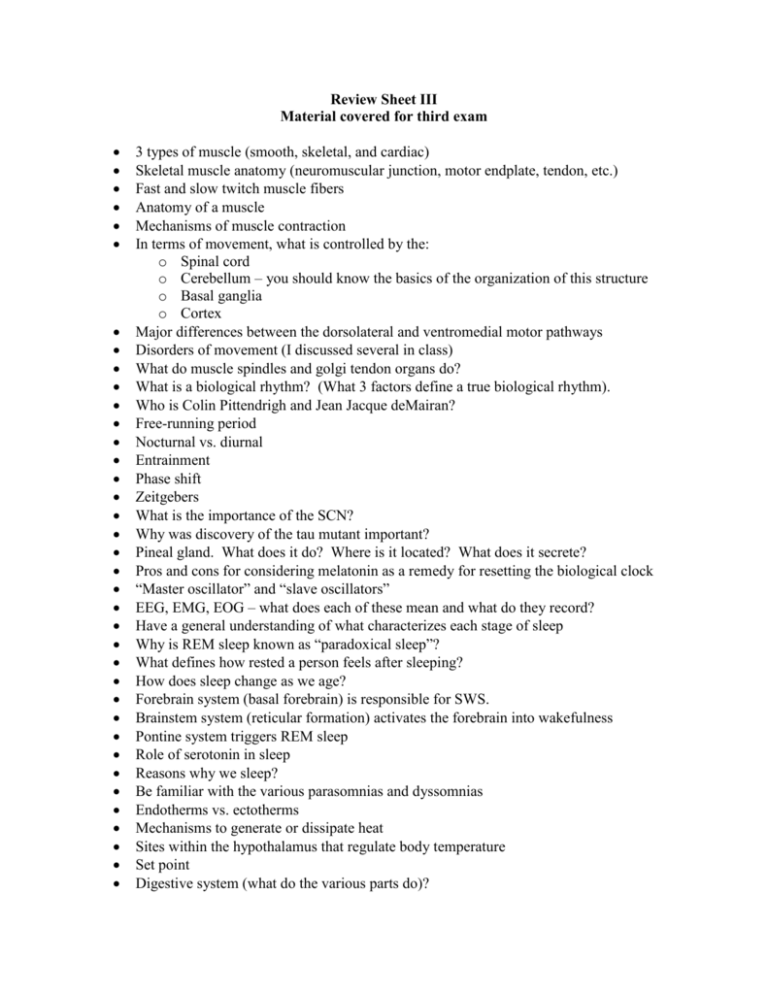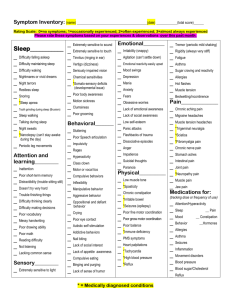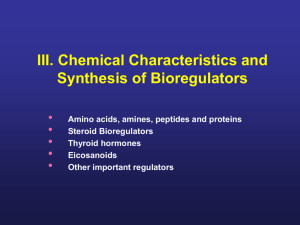Review SheetIII
advertisement

Review Sheet III Material covered for third exam 3 types of muscle (smooth, skeletal, and cardiac) Skeletal muscle anatomy (neuromuscular junction, motor endplate, tendon, etc.) Fast and slow twitch muscle fibers Anatomy of a muscle Mechanisms of muscle contraction In terms of movement, what is controlled by the: o Spinal cord o Cerebellum – you should know the basics of the organization of this structure o Basal ganglia o Cortex Major differences between the dorsolateral and ventromedial motor pathways Disorders of movement (I discussed several in class) What do muscle spindles and golgi tendon organs do? What is a biological rhythm? (What 3 factors define a true biological rhythm). Who is Colin Pittendrigh and Jean Jacque deMairan? Free-running period Nocturnal vs. diurnal Entrainment Phase shift Zeitgebers What is the importance of the SCN? Why was discovery of the tau mutant important? Pineal gland. What does it do? Where is it located? What does it secrete? Pros and cons for considering melatonin as a remedy for resetting the biological clock “Master oscillator” and “slave oscillators” EEG, EMG, EOG – what does each of these mean and what do they record? Have a general understanding of what characterizes each stage of sleep Why is REM sleep known as “paradoxical sleep”? What defines how rested a person feels after sleeping? How does sleep change as we age? Forebrain system (basal forebrain) is responsible for SWS. Brainstem system (reticular formation) activates the forebrain into wakefulness Pontine system triggers REM sleep Role of serotonin in sleep Reasons why we sleep? Be familiar with the various parasomnias and dyssomnias Endotherms vs. ectotherms Mechanisms to generate or dissipate heat Sites within the hypothalamus that regulate body temperature Set point Digestive system (what do the various parts do)? Hypovolemic and osmotic thirsts (how do they differ)? Angiotensin II Where are osmoreceptors located? Aldosterone. Where does it come from? What does it do? Three phases of energy metabolism Pancreas. What two hormones does it secrete? What do each of these do? Type I and Type II diabetes Diabetes insipidus Lipostatic theory Other mechanisms controlling food intake and food processing o Taste o Duodenum and CCK o Neuropeptide Y and galanin o Stomach stimulation o Leptin Leaky-barrel model and settling-point Eating disorders Classes of hormones (protein and peptide, steroid, amino acid derivatives, fatty acid derivatives). Know the differences between each How are peptide hormones and steroid hormones made? How do peptide hormones and steroid hormones act? What hormone(s)/releasing factor does each secrete (testes, ovaries, pancreas, adrenal gland, pituitary, hypothalamus)? What does each do? Positive and negative feedback (how does it work)? HPG and HPA axes. Berthold’s experiment Critical period Activational/organizational hypothesis Aromatase hypothesis Two portions of the pituitary gland. What does each do? Mullerian and Wolffian ducts Turner’s syndrome, Klinefelter’s syndrome, TFM, 5-reductase deficiency, CAH. What are the characteristics of each? Who is Roger Gorski? What did he define? Aromatase and 5 reductase Who is Simon LeVay? What was his famous study? Definitions of sex/gender Who is John Money? Alpha-fetoprotein Temperature dependent sex determination Japanese quail (estrogen feminizes females. Males are the default sex) Zebra finches – how are they different? Gynandromorph Stress – what parallel pathways are activated? HPA axis – understand how feedback affects the secretion of the various components. Immune system – What are the two types and the two cells involved? What are some general differences between the two? How do glucocorticoids affect immune function?








